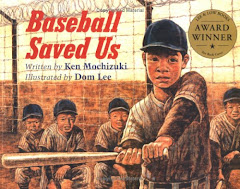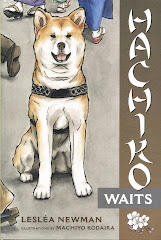A. Hachiko Waits
B. Lesléa Newman
C. Machiyo Kodaira
D. Scholastic Inc., 2004
F. 2-4
G. Hachiko Waits is based on the true Japanese story of a dog, Hachi (later given the honorable title Hachiko), who waits for his master at the train station everyday at a little before 3 PM. He does this for a while until one day his master dies suddenly at work and does not return on the train. A young boy, who had seen Hachi and his master at the train station everyday day, decided to take Hachi in but Hachi has other plans. The first chance he gets, Hachi leaves Yasuo’s house but continues to show up at the train station everyday just before 3 o’clock. The station master and Yasuo take care of Hachi and people give donations to buy Hachi food and keep him healthy and well. For ten years Hachi waits for his master until he dies of natural causes. The town celebrates the dog’s life with a statue that everyone views as good luck. Yasuo even meets his wife there.
H. This story is a touching story of faith, devotion, and hope. Everyday Hachi comes to the train station to wait for his master who will never step off the train. I really liked this book because the theme is so universal; it goes so much further than a dog waiting on his master. Hachiko was remarkable in more ways that one. He was much smarter than any dog that I know. I don’t know any dog that is able to “tell time,” or know what time of day to show up somewhere to meet a person. He also caught on very quickly to everything that his master taught him.
Yasuo was also an impressive character. I know that the Japanese culture is very different from the American culture, but I don’t know of any boy who would be so dedicated to taking care of a dog who didn’t even live at his house. Most boys would have quit taking care of the dog as soon as he ran away (especially if there were a station master who would make sure that the dog was taken care of). Yasuo was just so impressive in the way he honored Professor Ueno’s memory by taking care of Hachi. I just loved the way Yasuo kept his promise to take care of Hachi even though I’m sure that there were several times, especially as he got older, that he would have rather been doing other things.
The support Hachi got was also touching. I can’t believe the donations that the station master got to help take care of Hachi and the number of people who came to that train station just to see and touch Hachi for good luck. I was glad to see that there was a statue put up at the station after Hachi died so that people would remember the hope and the faith that Hachi represented for so long.
I. Hachiko Waits offers a great number of ideas for lessons. This book offers a great introduction into the Japanese cultures. By reading about Professor Ueno’s and Yasuo’s habits, students can learn about how Japanese people live, and what a typical day is like for a boy in
*Multicultural*











No comments:
Post a Comment